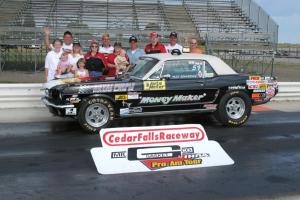I fixed the leaking gas tank and finally got a chance to test drive my
'87 Mustang GT with the new exhaust system. Basically, I added a Magnaflow
stainless steel cat-back exhaust system (2 1/2" diameter, p/n 15632) to the
stainless steel Motorsport shorty headers and stainless steel off-road H-pipe
(2 1/4" diameter, no catalytic converters) already on the car. The cat-back
system replaced the original aluminized steel Ford mufflers and tailpipes
(2 1/4" diameter). The engine has 150K miles on it and the long block has
never been touched. It has underdrive pulleys, bumped timing, no intake
silencer, and K&N panel filter but is otherwise stock.The Magnaflow kit for the '87-'93 Mustang GT's consists of several pieces.
Each side has a pipe ("flow tube") that goes from the H-pipe to the muffler,
a muffler, a tailpipe, and a turned down exhaust tip. The kit also comes
with a bunch of muffler clamps to hold everything together and new hangars
for the mufflers and tailpipes. As complete as it was, the kit did not come
with the 4 bolts that attach the flow tubes to the H-pipe or the two rubber
hangars for the exhaust tips. The instructions warn you to re-use these
parts from the original exhaust system. I was able to re-use the two rubber
hangars (though I'll probably order a new set) but I elected to replace the
bolts. For a high end DIY kit, it was annoying to leave these bits out.
The brackets for the muffler and tailpipes have no adjustment (side-to-side
or fore-and-aft). The fore-and-aft adjustment is handled by how far you
position the pipes inside the mufflers. I pushed them together as far as
possible but I still need to trim one tailpipe so the axle hop is centered
over the axle housing. The other side is centered but touched the tank
where the flange is bent up. I trimmed that off with a cut-off wheel only
to find I nicked the tank weld. The turn downs (required for the GT rear
skirt) are adjustable fore-and-aft and also in rotation by means of a bolt
and set screw (no muffler clamps required) that are not visibile once the
system is in place. The proper Allen key for the set screw was provided
with the kit.
I had several fitment issues but they may be due the exhaust location on
my car as one of my O2 sensors nearly touches the bellhousing. One of
the pipes touched the fuel line bracket so I had to reshape the pipe.
The stainless steel pipe is very strong and I had to put it in a vice
to shape it. I can usually crush a typical exhaust pipe with a big set
of channel locks but not this stuff. I ended up making the pipe oval in
cross section near the bracket for clearance.
The mufflers, pipes, and exhaust tips are all mirror finished polished
stainless steel and look too good to put underneath a car. Also, the
pipes are mandrel bent without any kinks. While the oval body muffler
case looks like a turbo style muffler, the Magnaflow mufflers in this kit
are not a turbo design reflective muffler. Instead the muffler is a
straight through design that keeps a constant diameter through the muffler
(no baffles, chambers, or area changes). There are also no louvers like
a glass pack. Instead there are holes at 90 degrees to the tube with
stainless steel packing all around.
Given the straight through design and the fact that I'm not running
catalytic convertors (convertors do a fair bit of silencing), I was
concerned the Magnaflow kit might be too loud for my daily driver. This
turned out to be a non-problem. The sound character is quite different
from a turbo muffler. It's barks at start up then settles down to a quiet
burble. The sound is very mellow and a function of load (throttle angle)
and RPM. The sound level increases until a certain RPM, then drops off
with increasing RPM. My guess is this is a resonant mode and is a function
of the pipe length (and probably cam timing). With my 3.08:1 final drive
ratio, there is a bit of cruise drone above 70 MPH or so but not too bad
(not noticeable with windows down). It does makes a nice popping and
crackling sound when backing off the throttle or downshifting. You can
modulate the sound level by small throttle angle changes. It will be
interesting to see how it sounds when I add the supercharger later this
year. I bet high compression will make the sound sharper.
The car seems stronger than before which surprised me. Given that the
H-pipe is 2 1/4 diameter and I'm still running stock heads, intake, and
cam, I wasn't expecting any sort of performance increase. Some of the
perceived performance increase may be due to the O2 sensors I replaced at
the same time but I don't think it has ever run this strong. Even just
rolling on the throttle in first gear, it will break the tires loose
easily.
Given the choice to do it over again, I'd probably still go with the
Magnaflow. I wanted stainless steel and the only current competition is
Borla and Bassani, both of which are $200+ more expensive.
Dan Jones







 Mustangsandmore Forums
Mustangsandmore Forums

 Ford Racing
Ford Racing

 Magnaflow Exhaust Install
Magnaflow Exhaust Install


